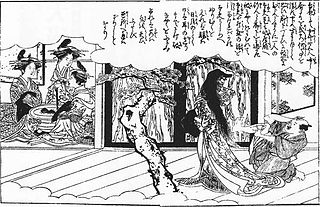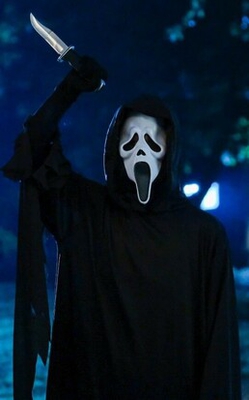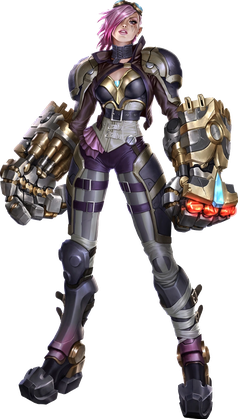Bloody Mary originally referred to:
The Licked Hand, known sometimes as The Doggy Lick or Humans Can Lick Too, is an urban legend. It has several versions, and has been found in print as early as February 1982.

Kuchisake-onna is a malevolent figure in Japanese urban legends and folklore. Described as the malicious spirit, or onryō, of a woman, she partially covers her face with a mask or other item and carries a pair of scissors, a knife, or some other sharp object. She is most often described as having long, straight, black hair, pale skin, and otherwise being considered beautiful . She has been described as a contemporary yōkai.

Urban Legends: Bloody Mary is a 2005 American direct-to-video supernatural slasher film directed by Mary Lambert, and starring Kate Mara, Robert Vito, Tina Lifford, Ed Marinaro and Lillith Fields.

Ghostface is a fictional identity that is adopted by the primary antagonists of the Scream franchise. The figure was originally created by Kevin Williamson, and is primarily mute in person but voiced over the phone by Roger L. Jackson, regardless of who is behind the mask. The disguise has been adopted by various characters in the movies and in the third season of the television series.
Korean horror films have been around since the early years of Korean cinema, however, it was not until the late 1990s that the genre began to experience a renewal. Many of the Korean horror films tend to focus on the suffering and the anguish of characters rather than focus on the explicit "blood and guts" aspect of horror. Korean horror features many of the same motifs, themes, and imagery as Japanese horror.
The killer in the backseat is an urban legend from the United States and United Kingdom. It was first noted by folklorist Carlos Drake in 1968 in texts collected by Indiana University students.

Pazuzu is a fictional character who is the main antagonist in The Exorcist horror novels and film series, created by William Peter Blatty. Blatty derived the character from Assyrian and Babylonian mythology, where the mythic Pazuzu was considered the king of the demons of the wind, and the son of the god Hanbi. In The Exorcist, Pazuzu appears as a demon who possesses Regan MacNeil.
Lilith is a fictional character on The CW Television Network's drama and horror television series Supernatural. The series' writers conceptualized her as a dangerous new adversary for series protagonists Sam and Dean Winchester to face, introducing her to stabilize the story arc in the third season by giving demons a new leader in the wake of the death of the villainous Azazel and maintaining her as the primary antagonist until the conclusion of the fourth season. During the third season, Lilith tries to kill Sam and Dean, ordering for their deaths at the hands of her minions. Early in the fourth season it is revealed that her goal is to free her maker, the fallen angel Lucifer, from his imprisonment in Hell. The protagonists' attempts to thwart her plan is the main plot of that season.

The first season of Supernatural, an American dark fantasy television series created by Eric Kripke, premiered on September 13, 2005, and concluded on May 4, 2006, after 22 episodes. It focuses on brothers Sam and Dean Winchester as they track down their father, John, who is on the trail of the demon who killed their mother and Sam's girlfriend. During their travels, they use their father's journal to help them carry on the family business—saving people and hunting supernatural creatures. Jared Padalecki and Jensen Ackles star as Sam and Dean, with Jeffrey Dean Morgan recurring as their father, John, and Nicki Aycox as the demonic Meg Masters. This is the only season to air on The WB, with all subsequent seasons airing on The CW, a joint venture of The WB and UPN. As of 2019, Supernatural is also the only continuing series that originated on The WB, and by far the longest running show ever to have aired on that network with over 300 episodes produced.
The Goetic demon Astaroth, whose name is derived from Ashtoreth, the biblical spelling of the name of the Phoenician goddess Astarte, has appeared many times in modern popular culture.

Bloody Mary is a 2006 horror thriller film written and directed by Richard Valentine and starring Jaason Simmons, Kim Tyler, Matt Borlenghi, and Cory Monteith. The film had a negative critical reception.
Hanako-san, or Toire no Hanako-san, is a Japanese urban legend about the spirit of a young girl named Hanako-san who haunts school toilets. Like many urban legends, the details of the origins of the legend vary depending on the account; different versions of the story include that Hanako-san is the ghost of a World War II–era girl who was killed while playing hide-and-seek during an air raid, that she was murdered by a parent or stranger, or that she committed suicide in a school toilet due to bullying.

Lilith, a biblical character suggested to be Adam's first wife and a significant female figure from Jewish mythology, has been developed over time into distinct characters in popular culture. One writer on witches, Judika Illes, wrote, "No spirit exerts more fascination over media and popular culture than Lilith. Her appearances are genuinely too numerous to count." Lilith is one of several figures with biblical or related origins integrated into popular culture who have been titled demon.
Jiangshi fiction, or goeng-si fiction in Cantonese, is a literary and cinematic genre of horror based on the jiangshi of Chinese folklore, a reanimated corpse controlled by Taoist priests that resembles the zombies and vampires of Western fiction. The genre first appeared in the literature of the Qing dynasty and the jiangshi film is a staple of the modern Hong Kong film industry. Hong Kong jiangshi films like Mr. Vampire and Encounters of the Spooky Kind follow a formula of mixing horror with comedy and kung fu.

Jinx is a character in Riot Games' League of Legends media franchise. She was introduced as a playable champion in the October 2013 update for the 2009 video game of the same name, which was complemented by the animated music video "Get Jinxed" to commemorate her official debut. Jinx is depicted as a manic and impulsive criminal from Zaun who serves as the archenemy of the Piltover enforcer Vi. The Netflix animated series Arcane explores the character's origin story as Powder, Vi's younger sister who, following a series of family tragedies, is taken in and raised by the crime lord Silco.

Piltover Enforcer Vi is a fictional character from Riot Games' League of Legends media franchise. She was introduced as a playable character, or "Champion" within series lore, in a December 2012 update for the 2009 multiplayer online battle arena video game of the same name, which was complemented by an official upload track to commemorate her introduction. She is presented as an impulsive and contemptuous woman who uses a massive pair of gauntlets powered with magical energy as her weapon of choice. Although she is nicknamed The Piltover Enforcer because of her association with the city's Guardians, she is a former criminal who hails from Zaun, originally the undercity region of Piltover. She is the archenemy as well as elder sister of the terrorist Jinx, another League of Legends Champion.

Daniel Robitaille, colloquially known as Candyman, is a fictional character and the main antagonist of the Candyman film series. The character originated in Clive Barker's 1985 short story, "The Forbidden". In the film series, he is depicted as an African-American man who was brutally murdered for a forbidden 19th-century interracial love affair; he returns as an urban legend, and kills anyone who summons him by saying his name five times in front of a mirror. The character is played by Tony Todd in Candyman (1992), Candyman: Farewell to the Flesh (1995), and Candyman: Day of the Dead (1999); Todd reprises the role in Candyman (2021), a sequel of the original 1992 film, with additional forms – souls brought into the Candyman "hive" – Sherman Fields, William Bell, Samuel Evans, George Stinney, James Byrd Jr., Gil Cartwright, and Anthony McCoy.










